Abstract
The causes of traffic crashes are complex and uncertain, among which the risky driving behaviors of drivers and the types of road sections in high-crash areas are all critical influencing factors. We used ArcGIS software to draw traffic heat maps under different thresholds to prevent the occurrence of traffic crashes accurately and effectively according to the vehicle GPS data of urban expressways in Jinan City, Shandong Province. This paper studied the relationship between risky driving behaviors (rapid acceleration, rapid deceleration, and overspeed) and road types with traffic crashes. The traffic safety evaluation model of urban expressways based on ordered logistic was established to predict the safety level of the urban expressway. The model’s accuracy was 85.71%, and the applicability was good. The research results showed that rapid deceleration was the most significant influencing factor of crashes on urban expressways. When the vehicle deceleration was less than or equal to −4 m/s2, the probability of a crash was 22.737 times greater than when the vehicle deceleration was at −2 to −2.5 m/s2; when the vehicle acceleration was greater than or equal to 3 m/s2, the probability of a crash was 19.453 times greater than when the vehicle acceleration was at 1 to 1.5 m/s2. The likelihood of a crash at a road section with a ramp opening was 8.723 times greater than that of a crash at a non-ramp opening; the crash probability of a speeding vehicle was 7.925 times greater than that of a non-speeding vehicle; the likelihood of a crash on a curve was 6.147 times greater than that on a straight. The research results can provide adequate technical support for identifying high-risk sections of expressways and active early warning of traffic crashes.
1. Introduction
Urban expressways play a significant role in promoting urban traffic development due to their continuous, rapid, large capacity, and unique use for automobiles. However, with the increased traffic load in recent years, urban expressways have frequently suffered from traffic crashes [1], decreasing their safety level. The crash causes of urban expressways involve four systems: people, vehicles, roads, and the environment. A single factor causes very few traffic crashes, with incidents usually resulting from several factors combined. The technical level, facility conditions, and traffic environment of the road are the essential elements of road traffic, which impact traffic safety and cannot be ignored. In some cases, they may become the leading cause of traffic crashes [2].
In addition to the elements of the road itself, drivers’ risky driving behavior is also a significant cause of road traffic crashes. Statistics show that the incidence of risky driving behavior in China is as high as 76%, and the probability of causing crashes exceeds 55%, among which the likelihood of crashes caused by rapid acceleration, rapid deceleration, and overspeed is over 40% [3]. Secondly, the rapid acceleration, deceleration, and overspeed of vehicles often make the engine work under heavy load, which not only consumes oil, increases wear, and shortens the engine’s service life, but also pollutes the air environment. If these high-risk road sections and risky driving behaviors can be identified, early warnings and reminders to drivers to pay attention to the danger would help reduce the occurrence of road traffic crashes, maintain good technical conditions of vehicles, and make specific contributions to environmental governance.
At present, there are many achievements in traffic safety risk research, mainly focusing on two aspects:
(1) Regarding road section type research: In 2018, Tsubota et al. [4] analyzed the relationships between pavement conditions and crash risks. They established a Poisson regression analysis model. The model estimation results showed that the age of road pavement positively affects the crash risk, and that age affects differences in different pavement types. In 2020, Liu et al. [5] chose the slope direction, the absolute value of the elevation difference, the standard deviation of elevation, the curve radius, and the transition curve ratio to describe the characteristics of road alignment. Combined with historical crash data, binary logistic regression models were established to analyze the effects of alignment factors on the frequent occurrence of three crash types (rear-end, hitting the fixture, and rollover). In 2019, Martin et al. [6] evaluated road safety from mobile LiDAR system data. In 2018, Lv et al. [7] used virtual simulation technology to identify dangerous sections of roads that have been built. The people–vehicle–road system model based on multibody dynamics was proposed using the software of ADAMS/Car. The high-risk and high-driving-load road sections were identified on the basis of roll and rollover evaluation criteria, combined with speed consistency theory. In 2017, Li [8] established a multilevel index system of expressway alignment safety evaluation and a comprehensive evaluation model based on extension theory. In 2021, Wang [9] found a prediction model of expressway traffic crash severity affected by road and environmental factors to explore the impact of road and environmental factors on crash severity.
(2) Regarding risky driving behavior research: In 2018, Saad et al. [10] used discrete Fourier transform (DFT) and discrete wavelet transform (DWT) to extract the vehicle trajectory data from the surveillance video, including acceleration, relative speed, and relative distance. They developed a driving style recognition and statistical method in such a way as to facilitate driving style recognition. In 2015, Thitipatanapong et al. [11] used rapid acceleration, sudden brake, rapid turning, and fast lane change to evaluate dangerous driving behavior to develop a vehicle monitoring system based on novel consumer-grade multi-satellite navigation receivers. In 2011, Miyajima et al. [12] established a driver risk evaluation model based on driving behavior records, plotted the maximum acceleration per minute to velocity on a two-dimensional plane, and approximated the distribution by linear regression. In 2021, Omidi et al. [13] explored the relationships linking traffic climate factors, driver behaviors, dangerous driving behaviors, and traffic crash involvement among taxi drivers. The results showed a significant negative correlation between functionality (of the TCS) and the number of crash involvements, and the effect of risky driving (of the DDDI) on crash involvement was significant. In 2020, Casado et al. [14] applied a latent cluster analysis as an initial tool for the fragmentation of crashes and a multinomial logit (MNL) model to find the most critical factors involved in driver injury severity.
Many scholars [15,16,17,18,19,20] have researched road section types and risky driving behaviors, but they mainly focused on simple data collection and subjective risk judgment. In addition, few articles comprehensively studied the influence of the two factors on traffic crashes. Most ignored the correlation among road section types, risky driving behaviors, and traffic crashes. They did not explore the influence degree of the two factors on traffic crashes fundamentally. Therefore, using GPS data of urban expressways, this paper analyzes the correlation between road section types, risky driving behaviors, and traffic crashes. It establishes an urban expressways traffic safety evaluation model based on ordered logistic. The model can reflect an urban expressway’s safety degree and effectively divide the safety degree level to realize the active early warning and prediction of traffic crashes.
2. Data Extraction
2.1. Research Road
This study took five urban expressways (two horizontal and three vertical) in Jinan City, Shandong Province, as the research object, namely, the Second Ring East Expressway, Second Ring West Expressway, Second Ring South Expressway, Shun He Expressway, and Bei Yuan Expressway. The abovementioned urban expressways are the main expressways in urban areas, with significant traffic flow and various types of road sections, which are representative. Table 1 shows the main parameters of five typical urban expressways.

Table 1.
Urban expressway parameters.
To improve the accuracy of urban expressway traffic safety assessment, we referred to the “urban road engineering design specification” (CJJ37-2012) [21] in the road plane and longitudinal section of the relevant provisions. We combined it with the actual situation according to the slope, turning radius, and opening conditions into eight road section types, as shown in Table 2. If the road slope was less than 3%, as the road was flat, and vice versa for the slope; according to the road grade, design speed, and other conditions, the road was divided into straight and curved; according to whether there was a plane intersection on the road section, the road was divided into two types with and without road openings. The five expressways were divided into 73 road sections according to the road section types shown in the table below and labeled.

Table 2.
Road section type division table.
2.2. Urban Expressway Vehicle GPS Data Extraction
2.2.1. Example of Vehicle GPS Order
The order format was as follows: 1701a73203743a3a0fe42273845701fe, 115.551850, 40.247620, 1498714199, 0.0, 165.5, 2, LOC_GPS, GCJ_02, DD_TAXI, Driver Not Working, 1.
The order meaning was as follows: user_id, longitude, latitude, timestamp, speed, direction, horizontal dilution of precision, data_source, coord_system, car_type, car_status, biz status.
2.2.2. Expressway Vehicle GPS Data Extraction
This study extracted vehicle GPS data in Jinan City from October 2019 to October 2020 on any 2 days in a month, totaling 24 days.
Since the original GPS data were affected by many aspects, such as tunnels and high-rise buildings, there was a certain proportion of incorrect data, missing data, and invalid data during the transmission process. The data orders did not contain height difference information; thus, it was necessary to preprocess the data and further screen the urban expressway driving data. The screening methods and steps are described below.
Abnormal data removal:
The original data were removed if the driving speed was unreasonable, if the driving direction angle was more significant than 360°, and if there was data drift.
- Data orders with speeds greater than 150 km/h, speeds less than 0 km/h, and all speeds of 0 km/h were removed.
- Data with a driving direction angle greater than 360° were removed.
- Data whose Euclidean distance () between the two data before and after was too large (based on the maximum speed of 150 km/h) were removed.
- Multiple duplicate data were removed.
- Intermittent data from order records were removed.
Non-urban expressway order removal:
- Sort each order by time.
- Vehicles driving on ordinary roads under expressways stop with different frequencies at the traffic light intersection; thus, a large number of orders with a speed of 0 km/h appeared at the latitude and longitude of the intersection and were removed.
- Vehicles driving on ordinary roads could turn at places not under the bridge crossing of the expressway; thus, orders that deviated from the expressway at the non-under passing bridge were removed.
Figure 1 shows the filtered data.
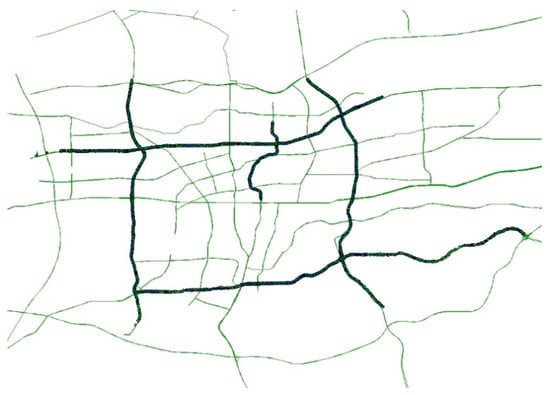
Figure 1.
Filtered data in ArcMap.
2.3. Calculation of Rapid Acceleration and Deceleration
First, the data were sorted by time in each order. Then, the ratio of the speed difference and the time difference was used to calculate the acceleration and deceleration between two adjacent recording points. The acceleration and deceleration speed could be extracted by the latitude and longitude. The classification interval of acceleration was as follows:
The classification interval of deceleration was as follows:
2.4. Overspeed Data Extraction
Overspeed is a dangerous driving behavior that drivers need to avoid while driving. Overspeed behavior can cause the vehicle to skid when turning, increase the vehicle’s braking distance, and reduce the driver’s dynamic vision and other dangerous hidden dangers, leading to traffic crashes [22]. The threshold for overspeed determination is usually based on the safe and credible speed limit (SCSL) [23]. The “Manual on Uniform Traffic Control Devices” recommends that the optimal value of SCSL should be of the 85th percentile speed value under the premise of free traffic flow. China’s “Road Traffic Signs and Markings Part 5: Speed Limit” (GB5768.5-2017) [24] stipulates that the speed limit value is usually based on the speed value of the 85th percentile of the operating speed, taking the value within the range of . Therefore, the road speed limit value is usually taken from the 85th percentile speed of the vehicle speed observation sample in the free traffic state. This study used the urban expressway speed limit value as the overspeed judgment threshold.
2.5. Crash Data Extraction
The crash data of the above five urban expressways in the last 5 years (from 1 January 2017 to 30 December 2021) were extracted by the traffic management bureau of the Shandong Provincial Public Security Department, yielding a total of 1683 cases. Four aspects were considered: the place of occurrence, latitude and longitude coordinates, crash type, and crash cause.
3. Data Analysis
The coordinate points under each threshold were imported into ArcMap, and the kernel density analysis method was used to generate the traffic heat map.
3.1. Acceleration Analysis of Urban Expressway
Figure 2a–e show the heat maps of the distribution of acceleration latitude and longitude coordinates under different thresholds. The color approaching red indicates greater acceleration under the threshold on the road section.
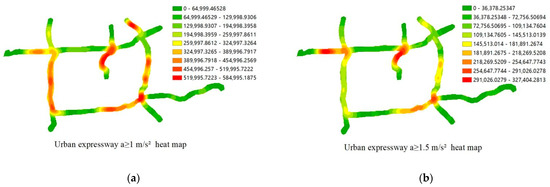
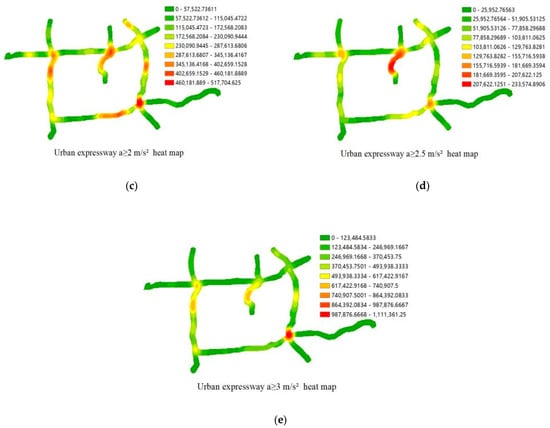
Figure 2.
Acceleration heatmaps at different thresholds. (a) is the urban expressway heat map. (b) is the urban expressway heat map. (c) is the urban expressway heat map. (d) is the urban expressway heat map. (e) is the urban expressway heat map.
3.2. Deceleration Analysis of Urban Expressway
Figure 3a–e show the heat maps of the deceleration latitude and longitude coordinates under different thresholds. The color approaching red indicates greater deceleration under the threshold on the road section.
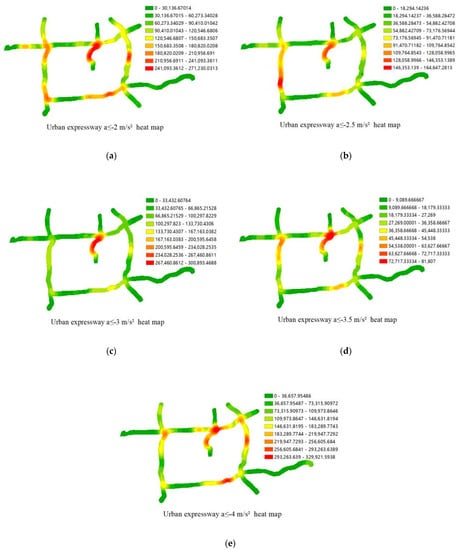
Figure 3.
Deceleration heatmaps at different thresholds. (a) is the urban expressway heat map. (b) is the urban expressway heat map. (c) is the urban expressway heat map. (d) is the urban expressway heat map. (e) is the urban expressway heat map.
3.3. Overspeed Analysis of Urban Expressway
Figure 4 shows the heat map of overspeed latitude and longitude coordinates on five urban expressways. The color approaching red indicates greater overspeed on the road section.
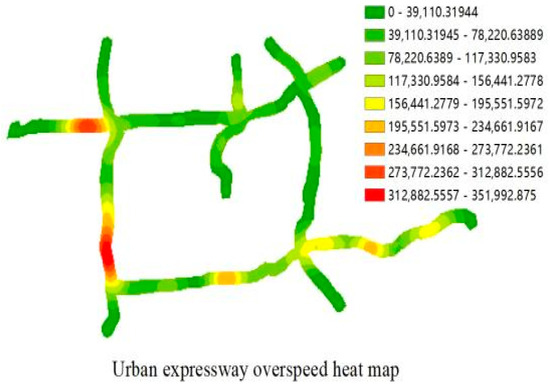
Figure 4.
Urban expressway overspeed heat map.
3.4. Analysis of the Number of Urban Expressway Crashes
Figure 5 shows the heat map of the distribution of latitude and longitude coordinates of crashes on the research road in the past five years, from 1 January 2017 to 30 December 2021. The color approaching red indicates more crashes on the road section.
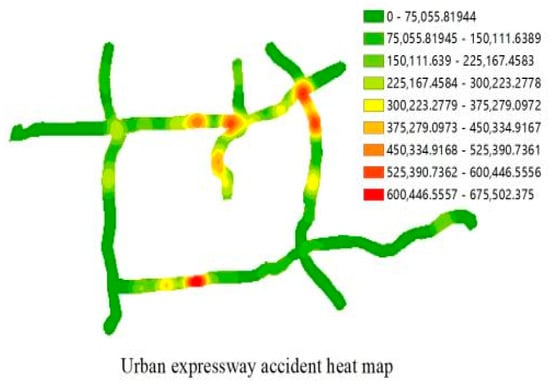
Figure 5.
Heat map of urban expressway crashes.
4. Establishment of an Urban Expressway Traffic Safety Evaluation Model Based on Ordered Logistic
According to the number of traffic crashes that occurred in each section of the urban expressway, the safety degree of road sections was divided into five levels: low risk (), low to medium risk (), medium risk (), medium to high risk (), and high risk () [25]. Aiming at the discrete and orderly characteristics of each road section’s safety degree, we used the ordered multiclassification logistic regression analysis method to establish the relationship model between the safety degree of urban expressway sections and its significant influencing factors.
4.1. Order Logistic Model Preparation
The safety level of urban expressway sections was taken as the dependent variable of the ordered multiclassification. As the safety level was divided into five levels, the ordered multiclassification logistic regression analysis model corresponded to formulasdefining the level of probability , , , , and . The constant term and the effect parameter are shown in Equation (3) for the four models fitted by n independent variables. SPSS software could estimate the corresponding parameters directly [26,27,28].
where represents the i-th cumulative logistic model, is the level of the indicated response variable (i.e., the safety level of the express road section), is the response variable, is the independent variable vector, is the intercept parameter of the i-th model, is the slope vector, and is the probability that the safety degree of the expressway section belongs to .
After obtaining the cumulative logistic model under each safety level of the road section, the probability that the safety level of road section belongs to each level is obtained as follows by conversion:
where are n influencing factors, and are regression coefficients.
If , the road section’s safety degree can be judged as class s.
4.2. Index Selection of Influencing Factors of the Urban Expressway Safety Degree
There are many causes of crashes on urban expressways. This study mainly started with the risky driving behavior of drivers and the type of expressway sections. The factors shown in Figure 6 were selected as the independent variables of the safety evaluation model.
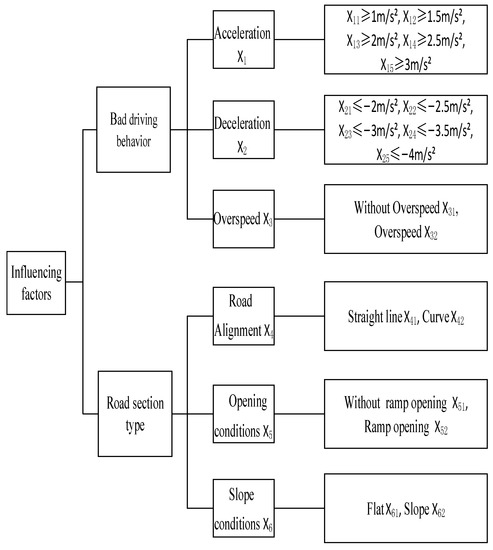
Figure 6.
Influence factor system framework.
We selected the sections of the Second Ring East Expressway, Second Ring West Expressway, Second Ring South Expressway, and Bei Yuan Expressway for the significance analysis of the influencing factors. The data sample information is as Table 3.

Table 3.
Data sample information table.
Sample data are shown in Table 4.

Table 4.
Data sample table.
4.3. Results from Analysis of Ordered Logistic Model
Table 5 shows the results.

Table 5.
Initial regression results table.
The significance of the software output parallel line test was 0.998, indicating no linear relationship between independent variables. The model likelihood ratio was less than 0.001, meaning that the model was statistically significant; the model goodness of fit Pearson and deviance statistics were 0.891 and 1, indicating that the model fit the data well [26].
OR was the ratio of a crash probability in the experimental group to the control group. The significance of the independent variable can be used determine whether it has statistical significance. When the significance value is less than 0.05, it is statistically significant at the 95% significance level. The significance value of the slope was 0.789, which is not statistically significant. Therefore, we chose to exclude it.
The remaining significant variables were further estimated. Table 6 shows the final parameter estimation results.

Table 6.
Final regression results table.
At this time, all the independent variables involved were at a high level of significance. The model likelihood ratio was less than 0.001, indicating that the model was statistically significant; the model goodness of fit Pearson and deviance statistics were 0.482 and 1, indicating that the model fit degree was ideal [26].
According to Table 6 and the above safety evaluation model, rapid deceleration was the most significant influencing factor of crashes on urban expressways. When the vehicle deceleration was less than or equal to −4 m/s2, the probability of a crash was 22.737 times greater than when the vehicle deceleration was at −2 to −2.5 m/s2; when the vehicle acceleration was greater than or equal to 3 m/s2; the probability of a crash was 19.453 times greater than that when the vehicle acceleration was at 1 to 1.5 m/s2. The likelihood of a crash at a road section with a ramp opening was 8.723 times greater than that of a non-ramp opening; the crash probability of a speeding vehicle was 7.925 times greater than than of a non-speeding vehicle; the likelihood of a crash on a curve was 6.147 times greater than than on a straight.
4.4. Model Validation
The above model was constructed from the data of the Second Ring East Expressway, the Second Ring West Expressway, the Second Ring South Expressway, and the Bei Yuan Expressway. Although the model passed the statistical correlation test and its fitting degree was ideal, whether it could characterize the crash characteristic mechanism of Jinan Urban Expressway still needed to be verified. The Shun He urban expressway was extracted and divided into 14 sections. According to the above modeling method, the relevant impact indicators were substituted into Equations (6)–(9). Table 7 shows the calculation results.

Table 7.
Model accuracy.
It can be seen from Table 7 that the accuracy of the model was 85.71%, indicating its good applicability.
5. Conclusions
This study proposed a method to analyze the correlation between drivers’ risky driving behavior and traffic crashes using GPS data and established the traffic safety evaluation model of urban expressways on the basis of an ordered logistic multiclassification regression method combined with road section types and traffic crash data. According to example verification, the model’s accuracy was 85.71%, indicating that it can effectively reflect an urban expressway’s safety degree and accurately classify the safety degree level.
The method proposed in this paper can be used to collect and analyze data and extract significant influencing factors according to the actual situation of the expressway under evaluation when evaluating the safety degree of urban expressways in other cities or regions; thus, this model has particular practical significance for assessing the safety degree of urban expressways.
The model showed that drivers’ risky driving behaviors (rapid acceleration, rapid deceleration, and overspeed) were more likely to lead to traffic crashes, among which rapid deceleration had the most significant impact. In addition, traffic crashes were more likely to occur at ramp openings and bends. The analysis results can prompt drivers to adjust their risky driving behavior in time to reduce the occurrence of traffic crashes.
The traffic safety of expressways is influenced by many factors, such as driver’s driving behavior, vehicle condition, vehicle type, weather, and traffic environment. This paper mainly studied two aspects: driving behavior and road section type. A follow-up study will explore the causes of urban expressway crashes in combination with traffic conditions, weather time, and other factors.
Author Contributions
Study design, H.X. and Y.H.; conceptualization, Y.W., J.K. and S.D.; methodology, Z.L.; draft manuscript preparation, Y.H. and Y.W.; manuscript revision, H.X., S.D. and J.K. All authors have read and agreed to the published version of the manuscript.
Funding
This research was supported partly by the National Natural Science Foundation “Driver safety identification of dangerous goods vehicle based on visual characteristics” (52102412), and the Natural Science Foundation of Shandong Province “Research on key technologies of road traffic accident chain blocking for Internet of Vehicles” (ZR2020MG022).
Institutional Review Board Statement
Not applicable.
Informed Consent Statement
Not applicable.
Data Availability Statement
The data presented in this study are available upon request from the corresponding author. The data are not publicly available due to security and privacy issues.
Acknowledgments
The authors are thankful for the support of Shandong Jiaotong University, the Shandong Key Laboratory of Smart Transportation (preparation), and the Traffic Administration of the Shandong Public Security Department.
Conflicts of Interest
The authors declare no conflict of interest.
References
- Yi, L.; Zhao, H.B. Research on traffic safety monitoring of expressway based on optical fiber sensing technology. In Proceedings of the 14th China Intelligent Transportation Annual Conference, Qingdao, China, 1 November 2019. [Google Scholar]
- Meng, Q.H.; Wang, B.G.; Wang, R.J. The research of human-vehicle-environment system based on transport safety. Veh. Power Technol. 2004, 02, 60–64. [Google Scholar] [CrossRef]
- Shandong Jiaotong University. A Monitoring Method and System for Bad Driving Behavior Determination Based on Accident Data; Shandong Jiaotong University: Jinan, China, CN201911021902.2.
- Tsubota, T.; Fernando, C.; Yoshii, T.; Shirayanagi, H. Effect of road pavement types and ages on traffic accident risks. Transp. Res. Procedia 2018, 34, 211–218. [Google Scholar] [CrossRef]
- Liu, Z.Y.; He, J.; Zhang, C.; Xing, L.; Zhou, B.J. The impact of road alignment characteristics on different types of traffic accidents. J. Transp. Saf. Secur. 2020, 12, 697–726. [Google Scholar] [CrossRef]
- Martín-Jiménez, J.A.; Zazo, S.; Justel, J.J.A.; Rodríguez-Gonzálvez, P.; González-Aguilera, D. Road safety evaluation through automatic extraction of road horizontal alignments from mobile lidar system and inductive reasoning based on a decision tree. ISPRS J. Photogramm. Remote Sens. 2018, 146, 334–346. [Google Scholar] [CrossRef]
- Lv, C.; Shi, D.F.; Gao, S.B.; Liu, S. The safety research of road alignment based on virtual simulation technology. Int. J. Eng. Syst. Modell. Simul. 2018, 10, 197–206. [Google Scholar] [CrossRef]
- Li, B. Research on safety evaluation of highway alignment based on extension theory. Highways 2017, 62, 181–185. [Google Scholar]
- Wang, K. Analysis and Prediction of the Severity of Freeway Traffic Accidents under the Influence of Roads and the Environment. Master’s Thesis, Beijing Jiaotong University, Beijing, China, 2021. [Google Scholar]
- Saad, M.; Abdel-Aty, M.; Lee, J. Analysis of driving behavior at expressway toll plazas. Transp. Res. Part F Traffic Psychol. Behav. 2019, 61, 163–177. [Google Scholar] [CrossRef]
- Thitipatanapong, R.; Chantranuwathana, S.; Noomwongs, N.; Boonporm, P.; Wuttimanop, P.; Klongnaivai, S. Vehicle safety monitoring system with next generation satellite navigation: Part 2 excessive acceleration detection. In Proceedings of the The 11th International Conference on Automotive Engineering, Bangkok, Thailand, 30 March 2015. [Google Scholar]
- Miyajima, C.; Ukai, H.; Naito, A.; Amata, H.; Kitaoka, N.; Takeda, K. Driver risk evaluation based on acceleration, deceleration, and steering behavior. In Proceedings of the 2011 IEEE International Conference on Acoustics, Speech and Signal Processing (ICASSP), Prague, Czech Republic, 22 May 2011. [Google Scholar]
- Omidi, L.; Mousavi, S.; Moradi, G.; Taheri, F. Traffic climate, driver behaviour and dangerous driving among taxi drivers. Int. J. Occup. Saf. Ergon. 2022, 28, 1482–1489. [Google Scholar] [CrossRef] [PubMed]
- Casado-Sanz, N.; Guirao, B.; Attard, M. Analysis of the risk factors affecting the severity of traffic accidents on Spanish crosstown roads: The driver’s perspective. Sustainability 2020, 12, 2237. [Google Scholar] [CrossRef]
- Weekley, J.; Barrell, J.; Mccarthy, T. Developing a road safety review tool to identify design standard and safety deficits on high risk road sections. Transp. Res. Procedia 2016, 14, 4130–4139. [Google Scholar] [CrossRef][Green Version]
- Kustra, W.; Jamroz, K.; Budzynski, M. Safety PL—A support tool for road safety impact assessment. Transp. Res. Procedia 2016, 14, 3456–3465. [Google Scholar] [CrossRef]
- Budzynski, M.; Jamroz, K.; Jelinski, L. The effect of road restraint systems on the level of road safety–polish experience. In Proceedings of the 5th International Conference on Road and Rail Infrastructure, Zadar, Croatia, 17 May 2018. [Google Scholar]
- Scott-Parker, B.; Weston, L. Sensitivity to reward and risky driving, risky decision making, and risky health behaviour: A literature review. Transp. Res. Part F Traffic Psychol. Behav. 2017, 49, 93–109. [Google Scholar] [CrossRef]
- Yang, L.H.; Zhang, X.Q.; Zhu, X.Y.; Luo, Y.L.; Luo, Y. Research on risky driving behavior of novice drivers. Sustainability 2019, 11, 5556. [Google Scholar] [CrossRef]
- Chen, S.D.; Xue, Q.W.; Zhao, X.C.; Xing, Y.Y.; Lu, J.J. Risky driving behavior recognition based on vehicle trajectory. Int. J. Environ. Res. Public Health 2021, 18, 12373. [Google Scholar] [CrossRef] [PubMed]
- Ministry of Housing and Urban-Rural Construction of the People’s Republic of China. Code for Design of Urban Road Engineering; China Architecture & Building Press: Beijing, China, 2012. [Google Scholar]
- Ding, S. The Research of Abnormal Driving Behavior Recognition Technology Based on Vehicle Dynamic Monitoring Data. Master’s Thesis, Beijing Jiaotong University, Beijing, China, 2015. [Google Scholar]
- Safe and Credible Speed Limits. Available online: https://road-safety.transport.ec.europa.eu/eu-road-safety-policy/priorities/safe-road-use/safe-speed/archive/safe-and-credible-speed-limits_en (accessed on 30 October 2022).
- Highway Research Institute of Ministry of Transport of China. Road Traffic Signs and Markings-Part 5: Speed Limit; China Quality Inspection Publishing House: Beijing, China, 2017. [Google Scholar]
- Xu, L. Application of Set Pair-Rough Set Comprehensive Evaluation Method in Navigation Safety of Port Waterway. Master’s Thesis, Dalian Maritime University, Dalian, China, 2013. [Google Scholar]
- Zhang, W. Advanced Course of SPSS Statistical Analysis; Higher Education Press: Beijing, China, 2004. [Google Scholar]
- Somboon, S.; Phunghassaporn, N.; Tansawet, A.; Lolak, S. Accuracy of machine learning logistic regression in death prediction for patients of road traffic injury. Asian J. Surg. 2022, 45, 537–538. [Google Scholar] [CrossRef] [PubMed]
- Zhao, J.; Wu, G.; Zhang, F.; Zhang, X.; Wang, H.T.; Cao, X.Y. Application of parameter estimation in logistic model. J. Phys. Conf. Ser. 2021, 1871, 12129. [Google Scholar] [CrossRef]
Disclaimer/Publisher’s Note: The statements, opinions and data contained in all publications are solely those of the individual author(s) and contributor(s) and not of MDPI and/or the editor(s). MDPI and/or the editor(s) disclaim responsibility for any injury to people or property resulting from any ideas, methods, instructions or products referred to in the content. |
© 2022 by the authors. Licensee MDPI, Basel, Switzerland. This article is an open access article distributed under the terms and conditions of the Creative Commons Attribution (CC BY) license (https://creativecommons.org/licenses/by/4.0/).